by Winding Pathways | Jul 4, 2024 | (Sub)Urban Homesteading, Bugs, Garden/Yard, Garden/Yard, Nature
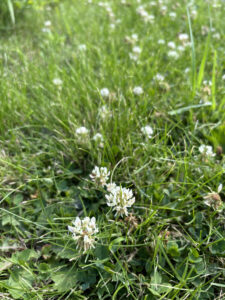
Mowers pass over low-growing clovers.
We recently discovered an amusing irony created by one of the most common lawn plants – white clover.
Sometimes called Dutch Clover, this low-growing plant graces unsprayed lawns in temperate regions across the globe. Normally, we discourage nonnative plants at Winding Pathways, but clover is an exception.
Although native to Eurasia, it’s not invasive. This important forage legume is likely the most widespread in the world. Diminutive clover is so low growing our mower passes right over its dainty flowers. Our friendly cottontail bunnies may seem to be eating grass, but actually, they’re feasting on clover. So are beneficial insects. As its flowers add beauty to the lawn and feed animals, clover’s roots pump nitrogen into the soil, helping other plants grow.
The irony
AI detected our Internet search for clover information. We began getting computer ads from landscaping companies encouraging us to hire them to kill our clover “and other weeds” in our lawn. No way!
Many people spend good money to poison beneficial lawn plants. They expose themselves, their pets, and anyone who walks on the lawn to toxic substances.
Maintaining a Healthy Bed of White Clover
White clover tends to gradually decline over the years. We’ve noticed this at Winding Pathways. To give it a boost we buy white clover seeds and sprinkle them on the lawn during cool months, especially on bare spots. Seed can be purchased online and in stores where hunters shop. These stores sell seeds beneficial to wildlife, and hunters often plant them to boost food for deer and wild turkeys.
-
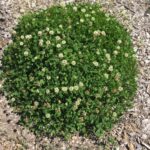
-
Clover can be manicured.
-
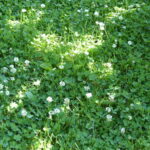
-
Sunlight on a clover lawn forms a cross.
-
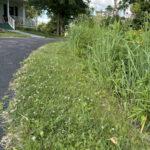
-
Dutch White Clover is low-growing.
Rewards
We have healthy lawns, rich with nitrogen. And, on summer mornings and evenings, we sit in our front porch’s rocking chairs watching bumble bees and bunnies foraging on our blooming white clovers. Thanks, clover.
-
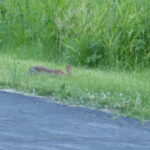
-
Bunnies enjoy clover.
-
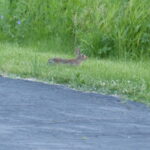
-
Watchful
by Winding Pathways | Jun 20, 2024 | (Sub)Urban Homesteading, Energy Efficiency, Nature, Trees
Connecting With Wood
Although we rarely watch sports on TV, the 2024 Iowa Women’s Basketball team captivated us. With athletic sneakers squeaking up and down the wood floor, Caitlin Clark’s sharpshooting and Hanna Stuelke’s blocks were amazing.
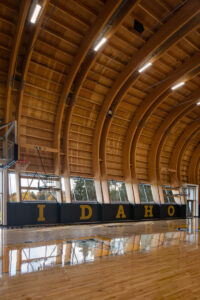
ICCU Arena Photography by Lara Swimmer. Images use restricted. Use by permission only.
About a month after the season, we entered an elite new basketball arena. Neither Caitlin nor Hanna was there, but we bet they’d love playing in a gorgeous new venue crafted mostly of wood. It’s on the University of Idaho campus.
“The arched ceiling beams are strong, beautiful, and crafted of local Douglas Fir and larch,” said Dean of the University’s College of Natural Resources, Dennis Becker, as he guided us through the University’s Idaho Central Credit Union (ICCU) Arena. It opened in October 2021 after about two years of construction and several more of planning and fundraising. Remember, this was during the Pandemic!
Modern, Flexible, and Beautiful Venue
After playing in the nearly century-old Memorial Gym and a few years in the massive Kibbe Football Dome, the University sought to create a gorgeous and flexible venue that enabled players and spectators to enjoy the intimacy of a largely wooden building that connects spectators with nature. Building it drew on the college’s academic strengths in forestry and wood technology, architecture, engineering, and athletics.
“Much of the wood used to create it came from the University’s Experimental Forest. In addition to being elegant its beams of laminated wood are sturdy, fire resistant, and gorgeous,” continued Dean Becker.
-
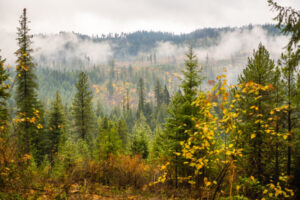
-
Logging and Maintenance at the Experimental Forest
-
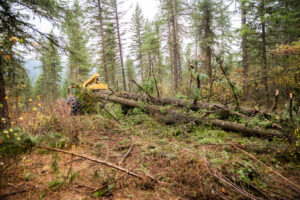
-
Selective logging
The Dean later explained that the reason the building feels warm and comfortable may be a concept expressed by Erich Fromm to describe the biological orientation humans have with all that’s alive and vital. Biophilia was expressed by the late Harvard professor E.O. Wilson as an affiliation people have with other life forms and nature as a whole, which is rooted in our biology.
-
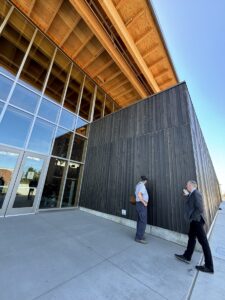
-
Gorgeous and modern
-

-
Courtside in background
-

-
Variety of woods
Connecting to Wood
Perhaps biophilia made us feel comfortable immediately after entering the Arena as it does in our Iowa home. In both places, we enjoy being enveloped in wood.
We recently visited friends in their brand-new home. Although functional and low maintenance, something about it was mildly uncomfortable. Crafted almost entirely of human-made products the home had doors of plastic, flooring of artificial planking, and walls of plaster. Even the cabinets were plastic. It lacked wood.
In contrast, our 1947-era home replete with wood feels cozy. Floors are white oak and Douglas fir with beams and rafters of pine, fir, and cedar. Our tables were crafted from red oak and black walnut and on the fireplace mantle is a polished cross-section of an oak crotch and a leaf carved from silver maple wood.
What Is It About Wood?
We love wood. It’s gorgeously individualistic. No two boards are exactly the same. It projects a warm and comforting feeling while having environmental benefits. Sustainably managed forests allow land to continually produce wood forever. It is also easy to reuse or repurpose.
Last winter we hired a company to refurbish our downstairs bathroom of easy-to-clean plastic and vinyl. It functions well, but something about it didn’t feel right. No wood. So, Rich bought a half-inch thick oak board, cut it to fit, finished it with a soft finish, and nailed it to a ceiling beam. That single piece of wood made the bathroom more comfortable.
Whether in a home or the University of Idaho’s Idaho Central Credit Union Arena, the beauty and function of wood make us feel at home.
-
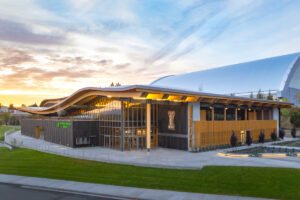
-
ICCU Arena exterior drone shots
-
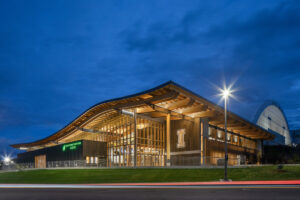
-
ICCU Arena photography by Lara Swimmer. Images use restricted. Use by permission only.
This is one of a three-part series of blogs stemming from a recent visit to our alma mater, the University of Idaho. The school offers an array of majors and is located in the rolling farmland of the Palouse and nestled below Moscow Mountain. For information check out uidaho.edu. Its College of Natural Resources offers majors ranging from wildlife biology to outdoor recreation, and forestry. It’s where Rich graduated. Marion received her MS from the Idaho College of Education, which features a variety of degrees, including movement science.
by Winding Pathways | Jun 6, 2024 | (Sub)Urban Homesteading, Nature
Gotta Love Media Hype
Just as the summer camping season began our local newspaper ran a story about dangerous animals. Snakes, bears, and mountain lions. It was scary enough to keep anyone out of the woods or campsite.
Are they really dangerous? Well, we’ve been tromping through woods, deserts, wetlands, canyons, and mountains for nearly 70 years in places where these animals sometimes lurk. Here’s what we have learned and had confirmed by “experts” on how to avoid confrontations with them.
Mountain Lions
Over years of hiking and camping in Idaho, Colorado, Arizona, New Mexico, and South Dakota mountain lion range we’ve never seen one. The odds of encountering a lion are minuscule. If one is around, it’s likely hiding or beating a hasty retreat. People are dangerous, by the way.
According to the Mountain Lion Foundation, the odds of being fatally attacked are about one in a billion, or longer odds than winning a billion-dollar lottery. Still, there have been seven fatal attacks in the past 25 years. Our advice: Odds of seeing a lion are amazingly unlikely but if one is spotted, stay a long way away.
Snake Adventures
We’ve unwittingly walked right past rattlesnakes in South Dakota, Idaho, and Iowa, and once spotted a copperhead near our tent in southern Missouri, but we’ve never been threatened by a poisonous snake. But we have had a few snake adventures.
Little Shovel Gets the Job Done
Once, when our family lived in Florida, Marion’s mom hollered for us kids to get inside. She rarely hollered so we did. Then, she told the older kids to get the neighbor. She had been hanging clothes when a coral snake wandered by. Mom, at all of 4’10” grabbed a huge shovel and pinned the snake in the sandy soil. Our neighbor came over with a little toy shovel, chopped up the snake, and pitched it into the wood pile. The very one where we used to sit in and eat oranges after playing in the orange grove. We found a new place to sit.
Billy Goat Gruff Adventure
When we were new to Iowa Byron Arnold, then a science teacher at Washington High School in Cedar Rapids, took us rattler hunting. Just to see them, not to hurt them. Byron and Rich took off with long strides while Marion, with shorter legs, and curiosity about the emerging wildflowers lingered. Realizing she’d lost sight of the guys, she hopped onto a large flat rock to be greeted in “Billy Goat Gruff” style by a timber rattler underneath inquiring, “Who’s that walking on my rock roof?” Yipes! Now what? Backing up to the far edge, she used her best movement science technique of the running LONG jump off the rock and sprinted across the stone-littered open woods. BTW, the guys had walked right past that rock and never disturbed the gentlemanly timber rattler.
Aptly Named Park In South Dakota
When camping at Snake Creek Campground in South Dakota on a boiling hot summer day, we decided to walk widely mowed paths to the beach. The name of the park is aptly named. Usually, we walk side by side. That day we were going single file when Marion spotted an unusual shape on the edge of the path. A prairie rattler is known to be mean. She called to Rich to watch out. He then stepped closer for a better look. GAAK! The snake kindly retreated. We took the long road back to the tent and slept uneasily that night.
Stay Away From the Sharp End
At an Outdoor Writers Conference years ago, a dog handler who trains hunting dogs to stay away from the sharp end of the snake calculated that for every snake people actually see on a ramble, they have likely passed dozens of unseen snakes over their hiking years. Snakes avoid confrontation. Because people are dangerous!
Snake Facts
According to the University of Florida, the odds of being bitten are about one in 37,500. The chart on the webpage reveals the thousands of people who die from lung cancer and auto accidents. But people still smoke or live in polluted areas and drive cars. So why are we freaked about snakes? Publicity.
With modern antivenoms, very few people die of snakebite. Most bites occur when people handle or molest a snake. Our advice: Watch where you step or put your hands (i.e. if rock climbing in snake country). If you spot a snake, stay away from it. Never attempt to irritate it or pick one up.
Bear Stories
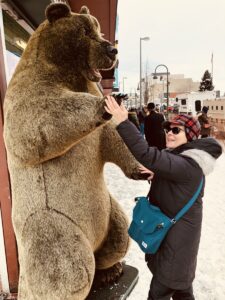
Close up with bears
Now, Bears are a different story. They range through most of the country but usually stay out of sight and away from people. And there are exceptions. Rich’s cousins tell a hilarious story of a bear climbing into the New Jersey suburban home, helping itself to kitchen goodies, and leaving its paw print on the wall as it left, all while the cousin and aunt huddled in the bedroom. Where was their cell phone? In the kitchen!
Friends of Marion’s in New Hampshire have bear adventures we’ve blogged about on Winding Pathways. And, in suburban New Jersey bears are routinely sighted at Cedar Lake. Marion has not been fortunate to see one, because she always smokes a stinky cigar from Denville Smoke Shop – obviously, this tactic works as bear repellent.
But, bears ARE around in suburban areas.
-
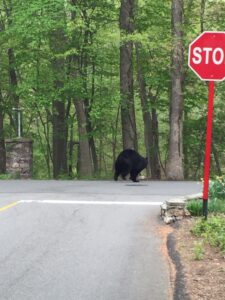
-
Suburban NJ has some prolific and big bears.
-

-
Picket fence torn apart by a hungry spring-time bear.
-
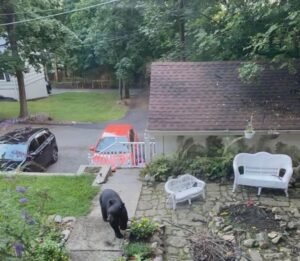
-
Bears make themselves at home anywhere.
Bear Facts
According to the National Park Service, the odds of a park visitor being attacked by a bear are one in 2.7 million. They are spreading and can cause mischief. Our advice: Keep a clean camp. Never leave food or other alluring objects with aromas (toothpaste, deodorant, perfumes in a tent. {why would one use any of these on a camp trip, anyway?} If a bear is spotted, stay a long way away, make noise, and slowly walk away from the animal.
What Animals Are Dangerous?
The best way to avoid trouble with any wild animal is to keep your eyes open and avoid conflict by staying a long way away.
Lions, snakes, and bears aren’t terribly dangerous but some animals are. Worldwide the most dangerous wild animal by far is the mosquito! According to the Advocates Injury Attorneys, the animals most likely to kill someone in the United States in order are:
- People. Homicides.
- Dogs.
- Deer. They don’t attack people. Deaths result from collisions with cars.
- Horses and Cows
- Bees, hornets, and wasps
At Winding Pathways, we encourage people to camp, hike, and enjoy the outdoors in their yards. Dangerous animals are not so abundant.
Threats posed by mountain lions, bears, and snakes are tiny and many can be prevented by using caution and common sense. Be cautious but go outside and PLAY!
by Winding Pathways | May 30, 2024 | (Sub)Urban Homesteading, Mammals, Pests
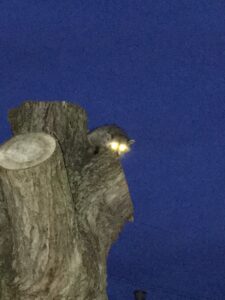
Raccoons are strong and hungry.
A raccoon kerfluffle with loud growling and snarling startled us to nearly jump from our chairs one May evening. It came from an oak tree 20 feet away from the house and close to our bird feeder. A flashlight beam on that pitch-black night revealed the culprits – three young raccoons high in the tree.
They quickly scurried down the tree and scampered out of flashlight range, letting us return to reading. Why was there a young raccoon kerfluffle? We can only guess but we’re certain they were there because of our nearby bird feeder.
What Raccoons Eat
At first glance, raccoons seem to be carnivores. They have sharp meat-eating teeth and look somewhat like a cross between a dog and a cat. Looks are deceiving. Raccoons are amazingly abundant across much of North America, in large part because they are opportunistic omnivores that seem eager to eat almost anything. They love frogs, crayfish, mussels, earthworms, fish, and any unfortunate mouse or vole they can catch. To a raccoon, a garbage can or dumpster is an invitation to dinner where they might discover delicious pizza crusts and an array of other discarded goodies.
Not Just Birds at the Feeder
Raccoons love fruit and grains. We have them in abundance. That is what lured them to our yard. To these cute but powerful animals, a feeder is an after-dark cafe. Most everyone is familiar with the determination squirrels show when attempting to reach even the most inaccessible feeder. Squirrels work feeders on the day shift while raccoons, deer, mice, voles,
skunks, opossums, bears, and flying squirrels often visit after dark when few people are watching.
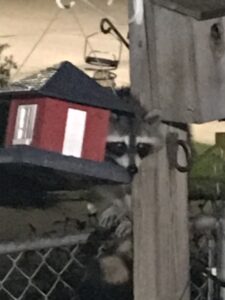
Raccoons are skillful climbers.
At Winding Pathways, we put expensive sunflower seeds in a feeder suspended by a metal hook on a slippery metal pole. It is so high even deer can’t reach it. But since many birds prefer feeding on the ground, we sprinkle cracked corn, millet, and a few sunflower seeds on the ground beneath the high feeder.
Usually, birds clean up all the seeds by sunset, but frequently some remain as darkness approaches. It’s always gone the next morning. Nocturnal mammals did the clean-up work.
After Dark Feeder Watching
Once in a while, we focus a flashlight beam on the feeder after dark. Often the eyes of deer glow back at us, and occasionally we spot other animals enjoying a seed dinner. Usually visiting raccoons eat quietly, but the startling noise we heard that night came from squabbling youngsters.
Adaptable Raccoons
Raccoons are amazingly adaptable. Our son lives in one of the most densely populated cities in the world – Brooklyn, NY. He occasionally sees a raccoon sticking its head up from a dumpster.
They are not just in North America. Raccoons were introduced to Russia to create a fur resource. They also were released in 1934 in Germany and have since spread far and wide and are increasingly common in Ukraine. Many Japanese people imported baby raccoons as pets and released some as they grew large and unruly. Today wild raccoons range through much of that Asian country.
Whether in Russia, Ukraine, or Japan they are exotic, invasive animals causing mischief. Although common in the United States they are native here and sometimes create a mess as they paw through a trash can or raid a chicken coop. However, they’re fascinating and beautiful animals that can often be spotted beneath a feeder in a flashlight beam.
The Nature Conservancy posts an excellent blog called “Seven US Species Invading Other Countries.” Raccoons top the list.
Nightly Adventure Continues
Since that evening, the trio of masked bandits that caused a raccoon kerfuffle have returned. Sometimes, like any siblings, they get along. Other times they disturb the night as they screech, snarl, and growl at each other until we shine a light on them or shoo them off. We can always count on some nocturnal adventure at Winding Pathways.
by Winding Pathways | May 9, 2024 | (Sub)Urban Homesteading, Foraging, Nature
Serendipity
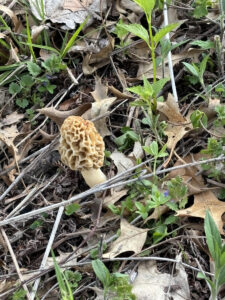
Morels appear like magic.
A surprise morel mushroom sighting was a serendipitous find for Marion. It happened on May Day 2024, in an area of Winding Pathways we’re rewilding. While seeking blooming bluebells and emerging May Apples she spotted the delicious fungus poking through last year’s oak leaves. We’ve since found more. With Cedar Rapids Houby Days just around the corner it looks like a good season for morels.
We own about two acres. Our house, garden, and lawn occupy about half our land. The rest we’re gradually rewilding to its native vegetation. Although we sometimes discover vegetative surprises in our unsprayed lawn, the most delightful new plants appear in our property’s “back 40”.
Nature’s Resiliency
Newly emerging species remind us of nature’s resiliency. A few years ago, a derecho’s 140-mile-an-hour wind knocked down many of our mature trees. Much of our land was shady, but the 40-minute storm transformed it into a sunny landscape. We’ve since noticed a dramatic decline in shade-loving ferns and an increase in sun-loving Wing stem. Other plants are fading and rising as the years go by.
We recently read that archeologists had found 4,000-year-old mullein seeds in an Egyptian tomb. When planted, they sprouted! Lots of native plants may not have the ability to stay viable that long, but they remain down in the soil, perhaps for decades, waiting for the right ecological conditions. Then they rise as if by magic. Other plants can spread their seed widely. Ones that end up in just the right place also sprout seemingly magically.
Pause for Thought
Ecological mysteries give us pause for thought and reasons to marvel at nature’s resiliency. We don’t know if our morels had been in the soil for years or if a spore had landed there more recently. Either way, this spring brought perfect conditions for their growth, and they appeared.
Enjoying Nature’s Abundance
We carefully picked our mushrooms, consulted with an experienced neighbor, and enjoyed them after preparing them and simmering in butter.
We’ll keep watching for others to appear.
Where Do Morels Grow?
Morels live across the country and usually appear in April or May. Hunting them is a popular activity. For information check these websites
Rewilding Winding Pathways
We’re gradually rewilding about an acre of Winding Pathways. Although many believe this simply means “letting nature take its course” we know that’s not feasible today because so many invasive species stress native plants. We manage nature lightly as we rewild our land. Here’s what we do.
- Remove the worst invasive species including Japanese Barberry, Asian Honeysuckle, Multiflora Rose, and Asian Bittersweet. As soon as we spot one, we unleash the lopping shears and chop it off as close to the ground as possible.
- Replaced three areas of lawn with native prairie.
- Carefully use prescribed burns to encourage natives and discourage invasives.
Natural or Native is Not Always Desirable
Two native species belong in our rewilding areas, but we discourage them because of the misery they can cause. We just keep them away from pathways. Here are the culprits:
Poison Ivy: It’s an important and valuable native plant for wildlife. Poison Ivy’s early spring leaves are an almost iridescent red, and they glow bright red in autumn’s fading days. Birds and deer devour the berries. Cottontails love eating the foliage and stems. All good except the itching. Both Marion and Rich are allergic to it and don’t enjoy the awful rashes that result from close encounters. We stay away from poison ivy and don’t cut it but spot-spray those plants growing close to pathways.
Virginia Tickseed: This interesting native doesn’t seem to be used much by wildlife, and it’s rather attractive. Come fall it produces zillions of small burs that are nearly impossible to remove from our clothes. We chop off any we find growing close to paths.
-
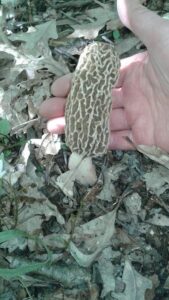
-
Morels’ distinctive shape. Credit Fitzgibbons
-
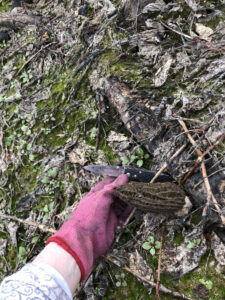
-
Carefully cut or break off a morel. Credit Fitzgibbons
Finding morels was exciting. We’ll likely find plants new to us springing up in our wilder areas. Most won’t be edible like morels, but they are fascinating and are living examples of nature’s resiliency.
by Winding Pathways | May 2, 2024 | (Sub)Urban Homesteading, Garden/Yard, Nature
Field Pussytoes delight us! (And, we plan to encourage them)
Early this spring a lawn care company dropped by and offered to spray our lawn. “We’ll keep the weeds out,” said the enthusiastic young man.
He knocked at the wrong door. We take joy in our lawn’s diversity, and soon after he visited delightful patches of Field Pussytoes sent up stems with their flowers in our lawn. Serendipity.
Field Pussytoes has the intriguing scientific name of Antennaria neglecta. Ours is one of several species of pussytoes that grace unsprayed yards. The word antennaria comes from the plant’s spikey flowers that look like an insect’s antennae. And neglecta? Well, because we are “neglecting” our lawn by not poisoning it, this humble plant thanks us. It needs little care and grows across much of North America.
This native plant thrives in conditions that describe most lawns. It enjoys full sun to partial shade, spreads by rhizomes, and is one of the earliest lawn “weeds” to flower. Its delicate blooms look like a kitten’s feet and toes. Field Pussytoes is pollinated by insects but bypassed by deer and rabbits.
Many years ago, Marion interviewed Lady Bird Johnson at the Lady Bird Johnson Wildflower Center near Austin, Texas. No doubt the former first lady enjoyed blooming pussytoes. The organization she formed has an outstanding website that helps anyone identify and enjoy plants.
Winding Pathways Lawn Management
We don’t neglect our lawn. We encourage native plants that need little care and which enrich the soil. As needed, we run a mower over it, but we’re always on the lookout for unusual plants that volunteer amid the grass. Some are delightful, and a few could be pests, but all are fascinating.
Our lawnmower helps us select the most interesting plants. Many that we might not want, like invasive sweet clover and garlic mustard, tend to grow tall. Our mower never gives them a chance. Field Pussytoes, like violets, hug the ground and escape the mower’s whirling blade. When done blooming, the plants form loose, sage-green mats that need no mowing at all! Gradually they’ve expanded.
One of the fundamentals of classic ecology is that diversity implies stability. Spraying a lawn destroys diversity, creating an unstable monoculture. We escape cost and possible chemical danger by not spraying our lawn. Pussytoes are just one of many fascinating plants that moved in and have spread on their own.
-
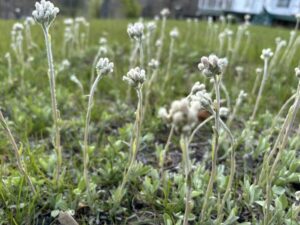
-
Blooms stand up several inches.
-
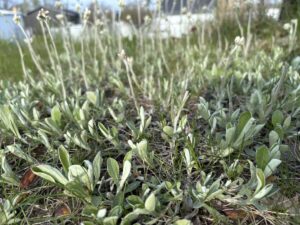
-
Field Pussytoes hug the ground

























